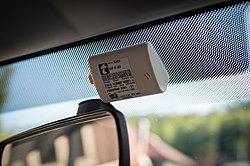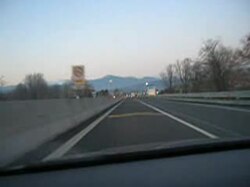Toll in Italy

In Italy , a route-dependent toll ( Italian : pedaggio ) is levied for most motorways . The different colored motorway signs can be used as a rough guide . Highway-like roads that have signs on a blue background and resemble the German Autobahn sign ( sign 330 ) are generally free of charge.
The total network has a length of 6,600 km, of which 5,695 km are operated by 24 licensed operating companies and 900 km in the south of the country by the state road operating company ANAS . The largest operating company is Atlantia SpA (until 2007: Autostrade SpA), which maintains a network of 3400 km in northern and central Italy. Other large companies are ASTM and ATP in the north-west, Serenissima and Autovie Venete in the north-east, and SALT and Autocisa in central Italy.
History and societies
In 1950, the first privately organized operating company for traffic route construction in Italy was founded, Autostrade Concessioni e Costruzioni SpA , with the aim of repairing the war damage to the Italian traffic infrastructure together with other companies. The first major construction project in Italy was the A1 Milan - Naples (also called Autostrada del Sole ) built from 1956 . In 1997, the state infrastructure company ANAS and what was then Società Autostrade agreed to extend the license from 2018 to 2038. Until it was privatized in 1999, the Italian state owned the company. The company has been listed on the stock exchange since 1987.
The parent company operates under the name of Atlantia SpA (until May 2007: Autostrade SpA ). It has a 100% stake in Autostrade per l'Italia SpA, which in turn u. a. is directly and indirectly involved in eight licensed motorway operating companies in Italy, companies for traffic control and various other companies in Italy and abroad with different shares. It is the largest operating company.
In total, the Italian motorway network is built, maintained and operated by 24 licensed operating companies. The supervisory authority is the Italian road construction company ANAS , which is run in the legal form of a stock corporation with one shareholder .
Toll systems and toll-free routes
Closed system
Most routes are operated in a "closed system", i. H. the amount of the toll is determined by the distance traveled and the road used as well as the vehicle class (1 for cars and motorcycles, 2 for mobile homes, buses, trucks, and 3 for cars with single-axle trailers, trucks with three axles, etc.). Roads with high construction and maintenance costs, such as the mountain highways with many tunnels (e.g. the A10 ), have higher tolls than roads with low construction and maintenance costs. The approximately 615 km long journey by car from Milan to Rome costs 33.90 euros; a complete trip on the Autostrada del Sole ( A1 ) with bypassing Naples via the A30 to Salerno costs 47.10 euros.
Closed system - Freeflow
The so-called FreeFlow system is being used on the new A36 motorway in the north of Milan: there are no longer any toll booths on the motorway; instead, all entrances and exits are monitored by video. This means that the distance covered can be assigned to each vehicle or license plate. Payment must be made retrospectively within two weeks. For occasional users who do not have a user account, the payment turns out to be expensive. Problems also arise when using a rental car, because when paying online, all trips of the last 15 days are paid together without being asked - in this case, you cannot distinguish between your own trips and those of any previous or subsequent tenants.
Routes in the FreeFlow system :
- A60 near Varese, between Vedano Olona and motorway junction with A8
- A59 near Como, between Acquanegra and Villa Guardia (via motorway junction with A9)
- A36 near Milan, between Lentate sul Seveso and motorway junction with A8 (via motorway junction with A9)
Open system
A few routes are operated in the "open system". In this case, only a lump sum is charged for a section of the route with several interchanges or an entire motorway, regardless of the distance covered. The "open system" comes in metropolitan areas and z. B. on the A8 / A9 Varese - Milan , or Como - Milan used. The lump sum on this route between the Como-Grandate tollbooth (A9) and the Milano Nord tollbooth (transition to the A4 ) or the Milano Terrazzano tollbooth (transition to the A50 (Milan western bypass) ) is 3.00 euros.
Toll-free routes
The 443 km long section of the A2 from Salerno to Reggio Calabria , for example, is operated and maintained by ANAS itself and is therefore toll-free. The same applies to the A19 , A29 and A29dir motorways in Sicily . But also on various motorway junctions such as B. the A14dir or on the motorway feeder z. B. RA3 there is no charge to be made. There are also some city highways (tangents) on which no toll is charged.
Payment of the toll
calculation
In the “ closed system ”, a toll card is drawn from a machine at the entrance station. You insert this into the machine at the exit station and pay the calculated toll. If the entry card is lost when driving in the "closed system", the journey from the furthest entrance will be charged unless the user can prove (e.g. through hotel bills) that he has entered the motorway at another entrance.
In the “ open system ”, payments are made either as well or only when entering or exiting or in the middle of a section of the route.
Cash or card payment
In both systems, the toll can be paid in cash, with an Italian account card, with an Italian or foreign credit card or with a prepaid card (so-called Viacard ), which is also available outside of Italy. The billing systems of all operating companies have been completely interoperable since 1988, so that even if different operators use motorways in a "closed system" during a journey, payment only has to be made for the last exit. Until 1988, the toll had to be billed and paid for the transition from one motorway to another if both motorways did not belong to the same operating company.
Telepass
Users who do not want to pay with one of the payment methods mentioned can attach an on-board unit (OBU) called Telepass to the car or motorcycle, which reports every entry and exit on the motorway to the toll station. For this purpose, special lanes are provided for fully automatic processing at most toll stations; however, lanes with toll collectors (ital .: esattori ) and Viacard / credit card lanes can also be used if they are marked with the Telepass logo. The amount due is usually withdrawn from the user's current account or credit card once per calendar quarter .
Telepass Family
Telepass Family is open to all users who have a current account or an approved credit card in Italy , even if they are resident abroad, are not Italians and want to use vehicles with non-Italian registration numbers . A maximum of three license plates can be registered per OBU at the same time; The user can make changes himself via the web interface. The basic fee for Telepass Family is EUR 3.10 per calendar quarter plus Italian VAT, provided the toll in the quarter does not exceed EUR 258.23. In addition, the quarterly fee becomes a monthly fee of the same amount. There is no discount on the toll when using the basic product Telepass Family .
Telepass Ricaricabile
Telepass Ricaricabile is a Telepass variant based on credit. It has been available since March 2006 in Campania and Sicily on the Naples ring road , sections of the A3 , at the Caserta Sud tollbooths on the A1 and Pomigliano d'Arco on the A16 , and on the Sicilian A18 and A20 motorways . It does not require a current account or credit card and is therefore also suitable for foreign travelers. For a fee of 49.90 euros, the user receives an OBU, whose credit account can be topped up at the motorway service points ( Punti Blu ), in numerous bars and chain stores, as well as on the website and by phone. In addition to the desired toll credit (25, 50 or 75 euros), a fee of 1 euro per commenced 24 euro toll credit is charged for loading. Here, too, there are no discounts on the toll.
Rules worth knowing
Reversing or turning in front of toll booths is punishable by fines of up to 6,000 euros, driving bans for up to two years and keeping the vehicle used for up to three months. This also applies if it is not possible to drive through the selected lane, for example because the Viacard or credit card was not accepted or a Telepass lane was accidentally selected. In this case, the user has to call for help by pressing the Assistenza button . Either a toll collector (ital .: esattore ) appears or the user receives a receipt with the help of which he has to pay the toll. The vehicle is photographed.
Tolls that the user cannot pay immediately - for whatever reason - must be paid within 15 days, otherwise a processing surcharge applies. Post payment is possible with all Punti Blu as well as by bank transfer. Toll claims by the Italian operating companies are not enforced in Germany as part of the administrative procedure, but can be collected the next time a toll Italian motorway is used.
Pass roads and tunnels (excluding motorways)
Examples:
- Grosser St. Bernhard Tunnel (partly in Switzerland)
- Munt-la-Schera-Tunnel (partly in Switzerland)
- Stelvio Pass road (partly in Austria)
- Timmelsjoch High Alpine Road (partly in Austria)
Cities
In Milan and Bologna a car city toll is levied for the inner cities.
See also
Web links
- http://www.autostrade.it - Homepage of the operating company Atlantia SpA



